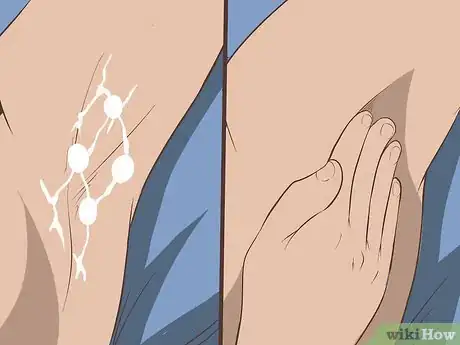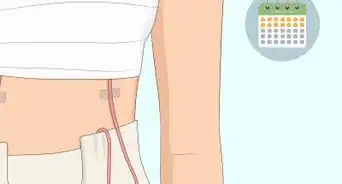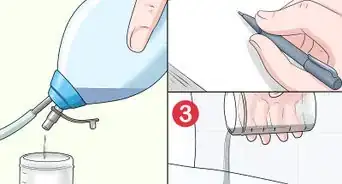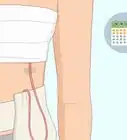X
This article was co-authored by Marsha Durkin, RN. Marsha Durkin is a Registered Nurse and Laboratory Information Specialist for Mercy Hospital and Medical Center in Illinois. She received her Associates Degree in Nursing from Olney Central College in 1987.
This article has been viewed 26,100 times.
If you would like to add a check of your axillary lymph nodes during your monthly breast self-examination, you can do so by palpating (or feeling) the 4 main parts of your armpit. However, keep in mind that an axillary lymph node examination is a clinical skill for trained medical professionals. If you think there is something wrong, make a doctor’s appointment to get checked out.
Steps
Part 1
Part 1 of 2:
Performing the Exam
-
1Relax into a comfortable position. Drop your shoulder into a relaxed position. Take a deep breath to help your body relax. Place your forearm on a table or the arm of a chair so that your arm and elbow are supported.
- You can also lie down on your back.[1]
- If you’re doing the exam on someone else, support their arm with your free hand.
-
2Moisturize your skin with lotion or soap to reduce friction. Applying lotion will allow your fingers to move more smoothly over your skin, making the exam easier to perform. This will also make any bumps or irregularities more noticeable to the touch. If you perform the exam in the shower, apply a little soap or body wash to the area.Advertisement
-
3Do the exam with 3 fingers of your dominant hand. Use your 3 middle fingers to feel for lymph nodes. Do not use your thumb, which is less sensitive. Feel with the pads of your fingers – where your fingerprints are.
- If you’re palpating someone else’s axillary nodes, use your right hand to check their left armpit, and your left hand to check their right armpit.[2]
-
4Press deeply in a circular motion. Your axillary nodes are rather deep into your armpit, so press in with firm, slow pressure. Move the pads of your fingers around in a circular motion. When you move your fingers to a different area, do it slowly and while exerting gentle pressure against the body.[3]
-
5Feel the 4 points of a diamond in your armpit. Start feeling for lymph nodes with your hand straight up, deep in your underarm, at the bottom middle of your armpit. Then feel 3 other points, making the shape of a diamond:
- Move your hand up and towards your chest, feeling underneath where your chest muscles (pectorals) reach your armpit.
- Move across your armpit horizontally towards your back, and feel under where your scapula (shoulder blade) reaches your armpit.
- Move up and to the middle of your armpit to where your arm joins your armpit and feel for nodes with the palm of your hand facing the bottom of your arm.
Advertisement
Part 2
Part 2 of 2:
Following Up on Palpable Lymph Nodes
-
1Take notes on what you feel. When you feel a swollen lymph node, write down what you feel. Take this to your doctor so they can make comparisons over time, then keep it handy so you can keep track of any changes. Write down the following information:
- The size: estimate to the closest centimeter, or use a ruler to measure from one side to the other.
- The shape: is it round, oval, or irregularly shaped?
- The firmness: is it soft when you gently press it, or firm and rubbery?[4] Roll your fingers over the node with slight pressure.
- The mobility: if you try to wiggle it gently, does it move around a bit or is it firmly fixed in place?
- Tenderness: is the lymph node sore or tender at all?
-
2Get large, firm, fixed, or sore nodes check out. If you feel a lymph node in your armpit that is less than 1 cm (0.4 inches), soft, and moveable, don’t worry about calling your doctor. These rarely indicate a problem. On the other hand, swollen nodes might mean you have inflammation, an infection, or another problem. Have your doctor take a look at your lymph nodes if you notice that any of them are:
- Fixed (not moveable)
- Firm
- Persistent (it’s normal for nodes to get big for under a week then go back to normal)
- Swollen, enlarged, or sore to the touch
- Causing you concern or discomfort for any other reason
-
3Schedule a doctor’s appointment to get checked out. See your doctor if you have an enlarged node that lasts longer than a week. They will talk to you about your medical history and do a physical exam. Depending on what they find, they may have you schedule an appointment for an ultrasound or mammogram. Follow-up with these tests like your doctor says to make sure there’s no problem that needs further monitoring or treatment.
Advertisement
References
About This Article
Advertisement



































































Medical Disclaimer
The content of this article is not intended to be a substitute for professional medical advice, examination, diagnosis, or treatment. You should always contact your doctor or other qualified healthcare professional before starting, changing, or stopping any kind of health treatment.
Read More...